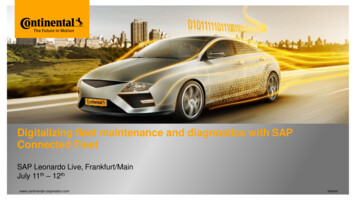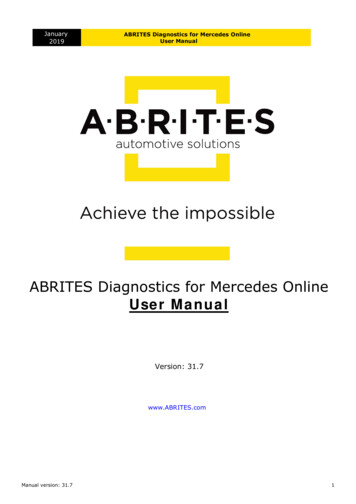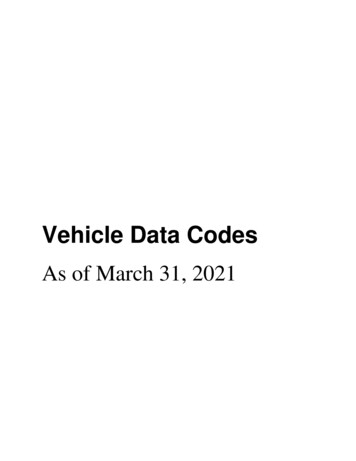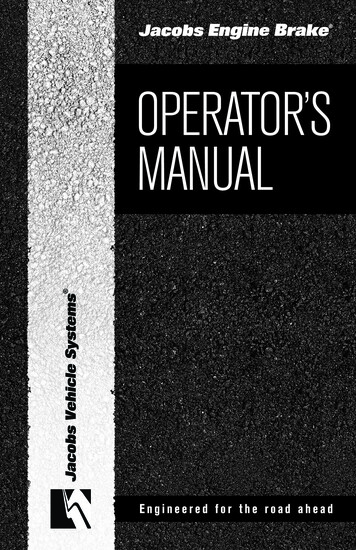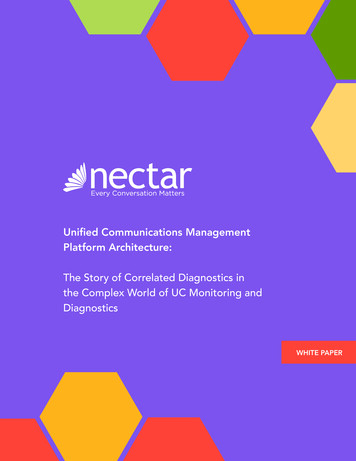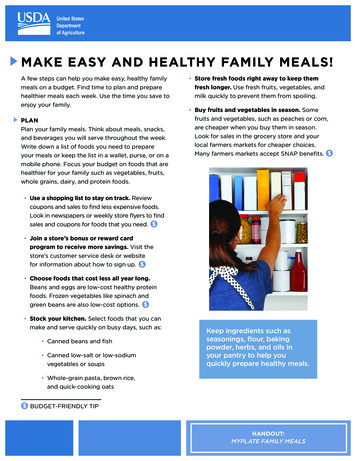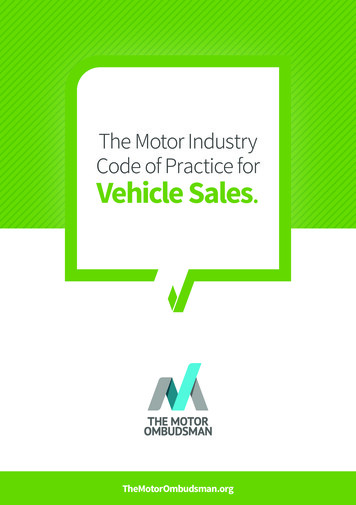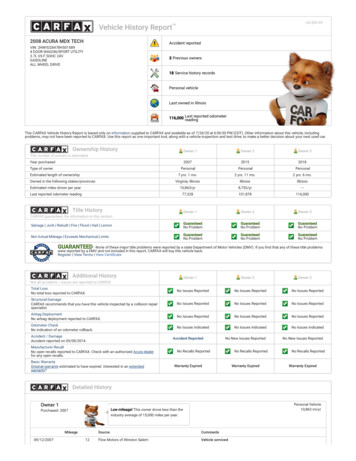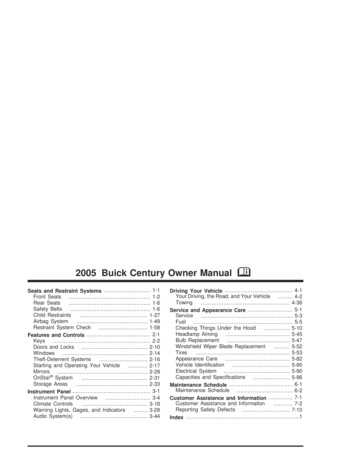
Transcription
Vehicle Diagnostics – The whole StoryEfficiency gains by standardization andthe use of tool-supported processes indiagnostic developmentThe development and introduction of new diagnostic concepts and diagnostic solutions offer significant potentialto automotive OEMs and suppliers for realizing efficiencygains and quality improvement. Growing complexity inautomotive electronics can only be mastered – technicallyand economically – by use of nonproprietary standardssuch as ODX, close cooperation and powerful tools. Thisarticle offers an overview of topics relevant to the past,present and future of automotive diagnostics as presented and discussed in October 2006 before an audience of350 participants at the Vector Congress in Stuttgart.20 years of automotive networking and diagnosticsThe fast growth of electronic functions in vehicles during the second half of the 1980s at first led to many insular solutions that prevented comprehensive concepts from taking hold in the area ofelectrical/electronic architectures. At the beginning of the 1990s aconsolidation phase began that was marked by development ofelectrical/electronic structures and associated networking topology from a comprehensive perspective. This meant that electrical/electronic content and its networking could claim an undisputed position in the vehicle. The recognition that many functionscould only be implemented sensibly with the help of electronics also prevailed. So the image of electronics transformed from being anecessary evil to being a key to new, interesting and innovativefunctions. The three bus nodes in commercial vehicles in 1989 havebecome more than 70 today in similarly equipped vehicles; see Figure 1. The underlying software amounts to about 10 million lines ofprogramming code.This trend has not been without consequences for diagnostics either. Twenty years ago the diagnostic capability of a function wasnot even considered until shortly before production startup. Todaybasic diagnostic functions usually exist as early as in the B-Sample.Handling of diagnostics has improved significantly. In the times offlash codes the process required that users tediously count thenumber of flashes and convert them to error codes based on printed-out tables. Today testers output instructions in clear text.In the past it was possible to do without tool support entirely. Today powerful diagnostic tools are an everyday reality. It is possibleto create the diagnostic specification, generate ECU-specific codeand parameterize the diagnostic tester utilizing the “single sourceprinciple”. A precondition is that specification of diagnostics mustbe shifted to the beginning of the development process (Frontloading); see Figure 2. The ODX format also enables cross-OEM exchangeof diagnostic data.Figure 1:Development of electronic networking based on the example ofthe E-Class model series W210(1995) and W211 (2002).1
From proprietary diagnostic tool to standard tool chainThe developing trend of diagnostic tools is similar to the trend ofelectronics in the vehicle. Back in 1990 automotive OEMs createdtheir own tools in-house. Specialists in different departments customized their tools precisely to their requirements and specific applications. This produced individual in-house solutions within eachOEM and even for different process steps.About 1995 automotive OEMs came around to a new way of thinking, i.e. that they wanted to once again focus more on their corebusiness. Accordingly, tool development was outsourced to external service providers. Initially, these outsourcers produced specialin-house solutions as well, but they succeeded in reducing the differences between tools and standardizing existing solutions withincertain limits. This trend continued until open, nonproprietary diagnostic tools became available on the market in the year 2000. Forusers, the route of product licenses is noticeably more cost-effective than assuming responsibility for developing and maintainingproprietary tools in-house. Moreover, there are shared benefits dueto synergistic effects of the combined experience of other marketparticipants. In 2005 the tools began to support general standards.Contemporary tools offer standardized interfaces that can beseamlessly integrated into existing tool chains.Old and new standards for diagnosticsStandards currently in the spotlight include the diagnostic datamodel per ISO 22901-1 ODX (Open Diagnostic Data Exchange, ASAMMCD-2D), the hardware interface per ISO 22900-2 (D-PDU API) andthe interface between the runtime system and the test applicationper ISO 22900-3 (ASAM MCD-3D, D-Server API). Each of the programming interfaces mentioned are available to the user as software libraries. Also worthy of mention are the diagnostic-relevantstandards per SAE J2534 and in the context of AUTOSAR standardization AUTOSAR WP4.2.2.1.4 (DCM, DEM). Furthermore, the UDS diagnostic protocol per ISO 14229-1 (Unified Diagnostic Services onCAN) will gradually replace older protocols such as the K-Line perISO 9141-2 and “KWP2000” as well as “KWP2000 on CAN”; see Figure 3.Characteristics of modern diagnostic solutionsThe development of comprehensive, homogeneous diagnostic solutions is a challenge. It requires studies and efforts on many different levels, in order to satisfy all requirements under one roof. Onthe one hand, this involves rationally creating powerful diagnosticsystems and on the other hand developing a user-friendly approach. It is only possible to realize these two goals with a universal, complete and practical diagnostic tool chain. Solutions must bespecified, implemented and documented for both the overall vehicle diagnostic system and diagnostics for specific ECUs. Furthermore, consistent management and distribution of diagnostic datamust be assured. That is because the applications of diagnostic solutions range from the development process with its many differentareas of focus, to quality assurance in production and finally diagnostics in the service garage.Figure 2:Diagnostic tool chain based onsingle-source principle utilizingstandardized exchange formats.2
The above-named standards serve as a foundation and buildingblocks for implementation of such comprehensive diagnostic systems. They benefit individual market participants without restraining natural competition. Besides achieving cost reduction, standardization brings the user additional advantages such as interchangeability of products, components and data. It can be expected that even more standards will be created in the future, which inturn will affect the tools used.the standardization committee. For suppliers, for example, it is crucial that they be capable of handling projects for different automotive OEMs with one and the same diagnostic tool. And to accomplisha gentle migration from the existing solution to the standardizeddiagnostic system, special temporary measures are often necessaryduring a transition time. In the introductory phase for new standards it is important to support multiple parallel versions in a consistent way.Practical capabilities are trumpOpenness for progress and innovationIn introducing modern diagnostic tools, focus on the needs of usersis of fundamental importance for their acceptance. The user shouldnot be confronted with the full complexity of the standards. Ratherit makes sense to present a diagnostically-driven perspective of thedata to the user. Special knowledge of the underlying data formatshould not be necessary. It is also important to optimize typical recurring work steps by guiding the user in performing the necessarytasks correctly, consistently and with time savings. In particularthis includes avoiding redundant processes and wherever possiblereusing already existing data material.Even if standardization and innovation seem to be two irreconcilable goals at first glance, automotive electronics is characterized bycontinual development. Progress is one of the most important keyperformance indicators for automotive OEMs and suppliers. Therefore expandability of currently used tool chains is always in demand, so that innovations and functionalities of future standardscan be utilized or tested in advance.Flexibility in handling customer-specific featuresIn all of the efforts to achieve uniformity and standardization increating powerful tools, it is important not to lose sight of flexibility. Current diagnostic standards offer a certain degree of latitudethat can be exploited to address supplemental requirements notcovered by the standard. These include customer-specific featuresand conventions or special wishes not supported by the majority ofEnough ideas and tasks still remain to ensure that in the future automotive electronics, networking and diagnostics will continue toimprove on the achievements of the last 20 years and adapt them tonew requirements. It must be assumed that the pace of innovationwill accelerate even more, and even closer collaboration will benecessary between automotive OEMs, suppliers and tool producers.This also pertains to a common approach in dealings with legislative bodies.Figure 3:The most important applied networking and diagnostic technologies over the past 15 years.3
VEHICLE DIAGNOSTICS – THE WHOLE STORYUniversal and automatic tool chainSimilarly, there is much future potential for diagnostics, now that ithas succeeded in quasi evolving from a “minor appendage to functions” to a “function in its own right”. This signifies the step fromsimultaneous development to integrated development, which results in even closer cooperation between diagnostic and functionaldevelopers. For the diagnostic system a model-based approach alsocame to fruition, which applies knowledge acquired from FMEA(Failure Mode and Effects Analysis) for example. Tools like DaVinciand CANdelaStudio from the Vector Informatik company, IQ-FMEAand Matlab/Simulink enable diagnostic design strategies utilizing auniversal and automated tool chain, from modeling tool to authoring system.Diagnostic developments at DaimlerChryslerDaimlerChrysler AG and Vector Informatik GmbH have expandedtheir close cooperation over the past several years, including in thearea of diagnostic tools. Easy and convenient use of tools and description of all diagnostically-relevant data in a uniform format areimportant principles of their joint projects. Data and diagnosticfunctions are only formally specified once in the solutions, whichare based on the “single-source principle”. Therefore they are universally available to all project participants and suppliers in machine-readable XML description files; see Figure 2.In CANdela (CAN diagnostic environment for lean applications)Vector Informatik structured its diagnostic product line-up withsufficient flexibility so that OEM-specific export formats could beintegrated. DIOGENES, the DaimlerChrysler-specific description data format, is also automatically generated and is then processed bythe uniform diagnostic runtime system. The requirements and experiences of other cooperation partners such as OPEL/GM and agricultural machine producer CLAAS have had significant influenceson the CANdela approach too. In the meantime Vector has also beenworking together with companies such as Fiat, Ford and numerousautomotive suppliers worldwide.Handling special project-specific features with templatesIn formal diagnostic description templates, or just templates, areimportant services for taking into consideration specific requirements of the manufacturer, project and vehicle model. Fully specifying diagnostics at a very early time prevents most misunderstandings, errors and iterative optimization loops in the diagnostic development process. The use of CANdela is firmly established in thedevelopment process at DaimlerChrysler. ECU suppliers not only develop the diagnostic functions in the ECU; they also supply the associated formal descriptions. Often standard software componentsare used to implement diagnostics in the ECU. The diagnostic component CANdesc (CAN diagnostic embedded software component)can be automatically generated from the CANdela data; see Figure2. This gives ECU and vehicle producers a way to achieve uniformimplementation of the diagnostic protocol across all products.ODX exchange format and UDS diagnostic protocolThe international standard ODX (Open Diagnostic Data Exchange)serves as the standard for exchanging data and nearly all diagnos-Figure 4:Complex bus networking in the LEXIONcombine harvester.4
tic information between individual tools, as well as between automotive OEMs and suppliers. It is being developed within the ASAMstandardization body (Association for Standardization of Automation and Measuring Systems) and is expected to be released as ISOstandard 22901-1 in 2007. DaimlerChrysler plans to replace its ownDIOGENES format by ODX on future projects.The CANdela approach handles import and export of ODX data andenables a smooth transition from proprietary formats to the standardized exchange format for suppliers. Moreover, the Vector ToolsCANoe, CANape, CANdito and CANdelaStudio support the new UDSdiagnostic protocol (ISO 14229), which DaimlerChrysler is introducing in all of its corporate divisions on each successive model changebeginning with the current C-Class where it will replace the previousKWP2000 protocol. DaimlerChrysler is relying on the standard ODX-Fformat for describing the flash data too. This is done with the flashdata management tool CANdelaFlash from the CANdela product line.In its diagnostic development process CLAAS runs through the VModel with the CANdela tool chain. CANdelaStudio is used to createthe specification of diagnostic functionality consistently. The captured data are used directly to generate the ECU-specific diagnosticsoftware component with CANdesc. To parameterize the testerCLAAS utilizes ODX data exported by CANdelaStudio, Figure 5.For a half year now CLAAS has also been using CANoe Option DiVa(Diagnostic Integration and Validation Assistant). DiVa makes itpossible to automatically generate and execute reproducible testcases for implementation and integration of the diagnostic protocol. Serving as requirements are internal CLAAS test specificationsand the diagnostic database. Suitably configured, DiVa permits testscenarios of varying depth and intensity, e.g. comprehensive testsor just tests of specific services. The program outputs detailedHTML test reports for error analysis purposes. In the future, automated testing with CANoe Option DiVa will be used for all CLAASECUs.Automating tests at harvesting machine producer CLAASAt Europe’s leading producer of harvesting machines, CLAAS, efficient development of diagnostic systems plays a key role. In a combine harvester there are up to four highly complex bus systems optimized for agricultural tasks; see Figure 4.The challenges facing the agricultural vehicle diagnostic system areenormous: 350 connectors with 3,000 electrical contacts, 3,000 mof copper lines, up to 25 ECUs or CAN nodes and numerous optoelectronic machine guards, potentiometers, valves, servo-drivesand speed sensors must all operate properly and work together.Joint diagnostic project by DaimlerChrysler and VolkswagenA joint project pointing the way to the future and simultaneouslyserving as a test case for new diagnostic standards and exchangeformats was the joint development of the new transporter generation “Sprinter” and “Crafter” by DaimlerChrysler AG and VolkswagenAG. The project executed under the name “Phoenix” started in theyear 2003 and reached its interim conclusion in mid-2006. Technically, the Sprinter and Crafter vehicles are for the most part identical and will be produced in various body configurations, weightclasses and equipment variants at DaimlerChrysler plants in Lud-Figure 5:Diagnostic development at CLAAS by theV-Model using the CANdela tool chain.5
VEHICLE DIAGNOSTICS – THE WHOLE STORYwigsfelde and Düsseldorf. Besides differences in body design, otherkey differences lie in each vehicle’s brand-specific powertrain.The initial idea for a diagnostic concept was to “translate”, so tospeak, the Sprinter diagnostic data from DaimlerChrysler to VW viaa central ECU in the Crafter. This would have made it possible toomit adaptation to the VW service tester, since to a certain extent itspeaks a different language due to incompatible diagnostic philosophies. However, this strategy was rejected in favor of modifyingthe service tester and exchanging diagnostic data by ODX. Stated insomewhat simplified form, an ODX converter now processes the ODXdiagnostic data generated by CANdela and uses them to prepare theODX data for VW, Figure 6. Existing components of the VW servicetester are not replaced, rather they are supplemented by otherfunctions needed for a migration.ODX: Trials passed successfullyIn this first joint diagnostic project the participating automotiveOEMs were able to acquire valuable experience, even though theywere confronted with difficult constraints. It was necessary to dealwith fundamentally different diagnostic philosophies involving different languages for coding, parameterization and control. Furthermore, all components contained in the diagnostic developmentprocess, such as export to ODX and the ODX standard, were still justin the development stage. Numerous internal departments and ex-ternal suppliers were involved, there was as yet no practical experience with the new ODX standard, and a tight schedule had to bemaintained. In the Phoenix project the performance of the ODXstandard was put to the test in a challenging large project and itpassed successfully.Future visions: Where does the road lead?With relentless progress in standardization many things are simplified, and it is possible to come to grips with new challenges. As ever, natural competition will generate a great deal of dynamism infuture development. Of course, it is impossible to predict exactlywhat effects this will have on vehicle electronics and diagnosticsystems of the future. However it can be stated with certainty thatthe significance of Internet technologies will continue to grow, asis also the case in many other technological areas. For example,“Diagnostics-over-IP” is conceivable. Initial studies with Ethernetand TCP/IP are already underway in conjunction with FlexRay gateways. If vehicles take on the position and functionality of a HTTPserver from an information technology perspective, general identification via IP addresses might make sense, for example, and thiswould make Vehicle Identification Numbers superfluous. Standardization will continue to advance in test modules and test procedures, and re-use in development, production and the service garage will become commonplace. Similarly, error messages in cleartext will become available on PCs and Web Browsers. PrerequisitesFigure 6:Cross-OEM exchange of diagnostic databetween DaimlerChrysler and VW basedon ODX.6
for this are diagnostic design concepts with universal and automatic tool chains that can generate diagnostic data for all components,from the modeling tool to the authoring system. Vector will help todrive sustained development of these innovative concepts.Literature:[1] Kühner, T.: “20 years of vehicle networking and diagnostics – What do weanticipate in the future?”, Vector Congress 2006[2] Schlingmann, N.: “Specification – Coding – Test: Development of diagnostic software”, Vector Congress 2006[3] Johanson, D.: “Introducing ODX diagnostics in a OEM joint venture project”, Vector Congress 2006[4] Rätz, C.: “What is the market demand for diagnostic solutions?”, VectorCongress 2006[5] Stimmler, S. and Rätz, C.: “On a solid basis – Efficient development of diagnostic functions in the automobile”, Automotive Electronics 2/2005Helmut Frank(Graduate Engineer)is a Business Development Manager at Vector Informatik responsible for the Diagnostics product line.Uwe Schmidts(Graduate Engineer) is a Marketing Coordinator at Vector Informatik whose responsibilities include the Diagnostics product line.7
automotive electronics can only be mastered – technically and economically – by use of nonproprietary standards such as ODX, close cooperation and powerful tools. This article offers an overview of topics relevant to the past, present and future of automotive diagnostics as prese

